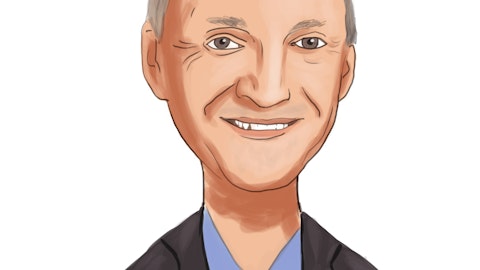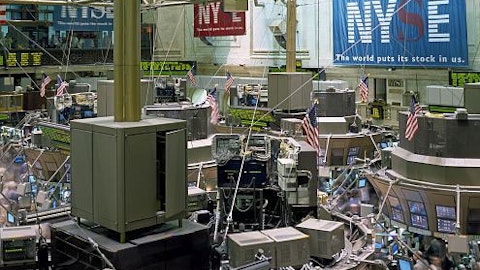And so, that’s where those two things start to marry up. But again, really as over the last 18, 24 months, as we’ve gone down this journey of the expansion of the global workforce, we very quickly realized that we needed to have our own operation where we could create the opportunity and have the rigor around the delivery of the service for our customers. And that was really at the forefront of this. The ambulatory market was a very nice secondary component to how we thought about the deal.
George Hill: That’s helpful, guys. Thank you.
Chris Fowler: Thank you, George.
Operator: Our next question comes from Jeff Garro with Stephens. Please proceed with your question.
Jeff Garro: Yeah, good afternoon. Thanks for taking the questions. I’ll start on the demand side of things. Just want to get any further color from you guys on what might catalyze customer prospect decisions from here? And then the second part of it is, while you’re trying to create some urgency with these prospects, how do you simultaneously set the appropriate expectations on the cash collection performance as one metric, and your ability to deliver the resources necessary to improve their financial outlook, so you just don’t want to overpromise while trying to get them over the line, and you’ve talked about some of the operational hiccups that you’ve seen over the last six to nine months? Thanks.
Chris Fowler: Yeah. Let’s see where to start with that. Let’s see, I guess, on the end, if I look at it from the operational standpoint, obviously, we’ve got the Viewgol team in here this week talking through what the integration plan looks like and how we can rapidly onboard staff inside of their operation and start delivering to the TruBridge operations. We’ve also expanded our partner set from the outsourced model to where we’re not reliant on. Not a single, but not being quite so single threaded on where that delivery comes from, and again, continuing to push hard on exactly what our expectations there are. And I think the interest of our own operation is going to create some urgency from those organizations as well to deliver — to make sure that they’re still partners with us going forward.
So that’s one part of it. I guess the catalyst — again, I’ll go back to, Jeff, from my perspective, there’s a couple of pieces of this. One, you’ve got the hospitals that probably their house is, I would say, a little bit on fire from the perspective of they’re not collecting the cash that’s available to go get. They’re in the high 80% of net cash collections, maybe low 90%s, and there is plenty of meat on the bone for us to jump in and immediately be able to deliver that return for them. I think the other thing really is just the distraction of things. When I think about specifically at our hospitals, 400 beds and under, if I’m the CEO there, and I’ve got 400 priorities on my desk, very few of those am I able to do outsource or give to somebody else.
There are things that have to be dealt with inside the facility, whether it’s new providers, new nurses, new facilities, new services, upgrades of facilities, going on and on and on, negotiation of contracts, a lot of that has to be done internally. This piece of work, this RCM work on the back-end is something that can be given away and can be very metric-driven to make sure that we’re delivering on what it is. And now with this component of us being able to — be able to get the cost structure even better related to our own workforce offshore, where it’s not — maybe it’s not quite so cost prohibitive for them to go forward with it. So, I think those are the catalysts as we think about going forward is driving home for our providers and our facilities, what is your mission, give yourself more bandwidth to be able to focus there, let us focus on the things that we are great at as well, and we continue to expand our partnership.
Jeff Garro: Makes sense. I appreciate those comments. One more for me. I want to ask about the revised guidance then. Just want to get a sense of your visibility into the rest of the year. Q4 usually a seasonally strong quarter and would expect quarter-over-quarter increases in revenue and profitability. But if you talk about specific drivers that would lead to those typical seasonal trends this year, I think, it would be helpful.
Matt Chambless: Yeah. So, the visibility into the next 90 days is generally going to be fairly strong. From a bookings to revenue conversion timeframe, we don’t have a lot of bookings that we expect to convert to revenues in that sort of a period of time. So, it’s really the expectations with the existing book of business for the top-line revenue. So that visibility, we feel like is there. And the cost side of the P&L where we do see some subjectivity and some seasonality, Jeff, most of that’s going to be seen down in the benefits area where the seasonality of people taking vacations can throw some noise into the P&L, but it’s usually to the benefit. So I’d say that from a seasonality standpoint, benefits primarily in G&A, where we expect to see the most movement.
Jeff Garro: Got it. I’ll hop back in the queue. Thanks for taking the questions.
Operator: There are no further questions at this time. I would now like to turn the floor back over to Chris Fowler for closing comments.
Chris Fowler: Thank you, Maria, and thank you, everyone, for your time this afternoon. And real quickly in closing, I’d like to acknowledge the hard work and passion that the people of CPSI bring each day to our company, our clients and the communities we serve. Clearing the way for care is not always a straight line nor an easy path, but we are driven to overcome challenges so that together, we can make a difference. Thanks again, and I hope everyone has a wonderful weekend.
Operator: This concludes today’s teleconference. You may disconnect your lines at this time. Thank you for your participation.




